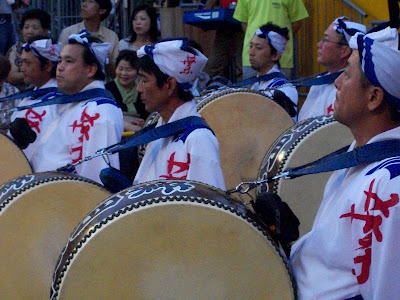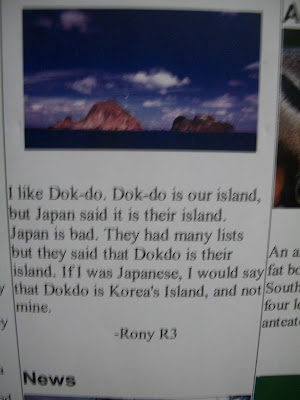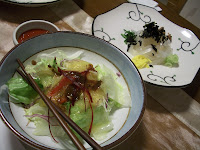So, I was going to compare Yosakoi to Tokushima ken's Awa-Odori festival, but then Blogger changed the font I was using and I couldn't change it back. So now for something not that completely different.
Tokushima ken is also on the island of Shikoku, but rather more connected to the real world. While Kochi is the last outpost of inaka-Japan, Tokushima is just a regular old prefecture. It's stunningly beautiful, although it lacks Kochi's rugged wilderness, but it has very similar weather (as does much of the island which borders the Pacific Ocean). So during the hot summer months when people in the cities are thinking about how to best honor their dead ancestors by floating a lantern down a river and telling the kids not to swim (lest the kappas drown you), Tokushima people get together in little groups and practice dances. Like Yosakoi, there is an established format that must be adhered to. While Yosakoi dancers are given the song "Yosakoi, Yosakoi" (or whatever it is called) to play and certain elements to include, Awa-Odori dancers are simply told to start their dance in a particular way - after the preliminary routine, which all groups do more-or-less identically, they can launch into something unique and creative.
Yosakoi dancers can wear any costume, I think. Some examples being:
It thought it was a link. I didn't hit the link button except twenty times later to un-link the typing input. Damn thing.
Awa-Odori dancers are required to follow a certain dress standard, including wooden geita for women, straw hats, and funny handkerchiefs. As follows:
The dance is also accompanied quite differently. In Kochi, those little trucks rumble down the boulevard before the dancers. Atop the trucks are singers, microphones, drummers, guitarists, or the karaoke machine that spits out the music at full blast. The sound is deafening, especially in the little enclosed corridors of the covered marketplace down which the dancers march. Awa-Odori is a little different. The dance teams enter a narrow arena and proceed to do their dance. They start at one side, next to the cheap seats, and get all the way to the far side, doing the whole routine somewhere along the way.
 |
| Gentlemen sit and await the start of their number. |
The sound is also very different. Remember what I said about Yosakoi singing and belting away into a microphone? In Awa-Odori style, there are only four instruments - shamisen, drums, flute, and the human voice. This does not make for a quieter, more serene and nuanced performance, however. So bring your earplugs.
 |
| Dude, second to left, has a big bell-thing, too. A terribly atrocious clang which only gets more horrid as he continues to ring! |
Both dances involve countless hours of preparation and commitment. You have to design and teach, learn and demonstrate brand new routines each year because people's memories are longer than the dance itself. If you repeat or steal a move, someone is bound to notice. But the atmosphere in both locales is festive and rockin'. There are few better ways to beat the summer heat than to march to a tuneful beat.
 |
| The festival street in Tokushima. |
 |
| The main stage performances in Kochi. |













































